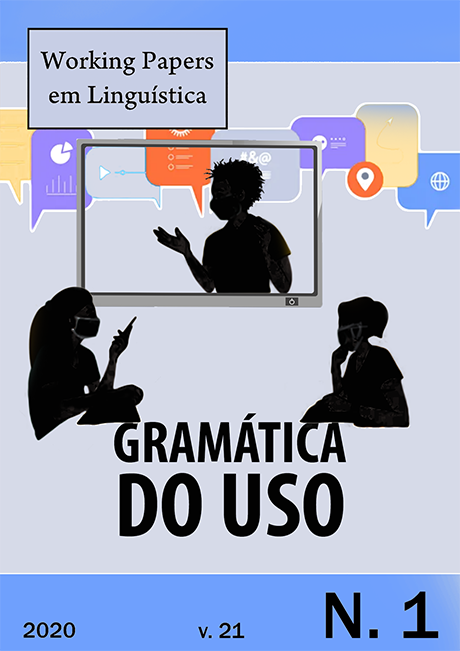Corpus approach towards narrative analysis of tense and aspect
DOI:
https://doi.org/10.5007/1984-8420.2020v21n1p278Abstract
This research, presented here, centers itself on how both tense and aspect are useful for the narrative analysis. This study presupposes narratives as texts with a temporal elaboration and progression, what demands abilities such as fore- and backgrounding. Such cognitive perspective is expected to dialogue with the Labovian position in the sense that the oppositions of fore- and background may be marked in the verbs. In order to understand how verbal tense and aspect are organized in spontaneous speech narratives in Brazilian Portuguese, the monologues from C-ORAL-BRASIL I minicorpus (RASO; MELLO, 2012) were manually annotated for the verbal categories as well as the Labovian categories (orientation, complication and evaluation). The results point to a tendency that complication will be marked mainly by simple past (pretérito perfeito do indicativo), while evaluation and orientation will be marked by present (presente do indicativo) and imperfective. Lexical aspect has shown an asymmetry between telic and non-telic verbs, and a slightly higher proportion of verbs of accomplishment and achievement in structures of complication.References
AZEVEDO, A. M. T. DE. Domínios discursivos: Uma visão cognitiva da estruturação de narrativas orais. 2005. 2005.
BARTHES, R. Análise estrutural da narrativa: pesquisas semiológicas. Tradução Maria Zelia Barbosa Pinto. Petrópolis: Vozes, 1971.
BICK, E. Parsing Speech Data: The Automatic Grammatical Annotation of the C-ORAL-Brasil Corpus. 2013, Belo Horizonte: Proceedings of GSCP 2012, 2013. p. 27–32. Disponível em: http://digital.casalini.it/9788866553519.
BICK, E. The Parsing System Palavras - Automatic Grammatical Analysis of Portuguese in a Constraint Grammar Famework. 2000. 505 f. Aarhus University Press, 2000. Disponível em: http://www.lavoisier.fr/notice/frYWOOR6SAS3WLLS.html.
BOGDAN, D. R.; SULLIVAN, W. J. Polish Tense and Aspect in Narrative Context: An Analysis of Written Text. Tampa Papers in Linguistics, v. 4, n. 2, p. 35–46, 2011. Disponível em: https://journals.flvc.org/floridalinguisticspapers/issue/view/4442.
CANÇADO, M.; AMARAL, L. L. Introdução à Semântica Lexical: Papéis temáticos, aspecto lexical e decomposição de predicados. Petrópolis: Editora Vozes, 2016.
CANÇADO, M.; AMARAL, L.; MEIRELLES, L. VerboWeb - syntactic-semantic classification of Brazilian Portuguese verbs - Faculdade de Letras. Disponível em: http://www.letras.ufmg.br/verboweb/. Acesso em: 31 jul. 2019.
CASTILHO, A. T. DE. Gramática do português falado. Campinas: Unicamp/Fapesp, 1990.
CASTILHO, A. T. DE. Nova gramática do português brasileiro. 1. ed. [S.l.]: Editora Contexto, 2010.
CHAFE, W. Somethings that Narratives Tell us about The Mind. In: BRITTON, B. K.; PELLEGRINI, A. D. (Org.). . Narrative thought and narrative language. Hillsdale, New Jersey: Lawrence Erlbaum Associates, 1990. p. 79–98.
COMRIE, B. Aspect. Cambridge: Cambridge University Press, 1976.
CRESTI, E. Corpus di Italiano parlato. Firenze: Academia della Crusca, 2000. v. 1.
CRESTI, E.; MONEGLIA, M. The C-ORAL-ROM Integrated Reference Corpora for Spoken Romance Languages. Amsterdam/Philadelphia: John Benjamins Publishing Company, 2005.
CUTRER, L. M. Time and Tense in Narrative and in Everyday Language. 1994. University of California, 1994.
DEMŠAR, J. et al. Orange: Data Mining Toolbox in Python Tomaž Curk Matija Polajnar Laň Zagar.
DOWTY, D. R. Word Meaning and Montague Grammar. Amsterdam: Springer, 1979. Disponível em: http://www.springerlink.com/index/10.1007/978-94-009-9473-7_1.
EDWARDS, D. Narrative: stories and Rememberings. Discourse and cognition. Trowbridge: Redwood Brooks, 1997. p. 263–294.
FLEISCHMAN, S. Tense and Narrativity: From Medieval Performance to Modern Fiction. London: Routledge London, 1990.
FONSECA, A. M. H. DA. Tempo, Aspecto, Modo / Modalidade (TAM) na expressão de futuridade. ESTUDOS LINGUÍSTICOS, v. 39, n. 1, p. 45–58, 2010. Disponível em: http://www.gel.hospedagemdesites.ws/estudoslinguisticos/volumes/39/v2/EL_V39N1_04.pdf. Acesso em: 31 jul. 2019.
HOPPER, P. J.; THOMPSON, S. A. Transitivity in Grammar & Discourse. Language1, v. 56, n. 2, p. 251–299, 1980.
LABOV, W. Alguns passos iniciais na análise da narrativa. The Journal of Narrative and Life History. Trad. de Waldemar Ferreira Netto, v. 7, p. 1–18, 1997.
LABOV, W.; WALETZKY, J. Narrative analysis. Oral versions of personal experience. 1967, Seattle and London: University of Washington Press, 1967. p. 12–44.
LANGACKER, R. W. Foundations of cognitive grammar. Stanford: Stanford University Press, 1987. v. I.
LÓPEZ-ORTEGA, N. R. Tense, Aspect, and Narrative Structure in Spanish as a Second Language. Hispania, v. 83, n. 3, p. 488–502, 2000.
MITTMANN, M. Análise da estruturação de diálogos e monólogos na fala informal: quantificando as diferenças - s. Domínios de Lingu@gem, v. 7, n. 2, p. 338–372, 2013.
MITTMANN, M. M.; RASO, T. The The C-ORAL-BRASIL informationally tagged mini-corpus. In: MELLO, H.; PANUNZI, A.; RASO, T. (Org.). . Pragmatics and Prosody: Illocution, Modality, Attitude, Information Patterning and Speech Annotation. Firenze: Firenze University Press, 2011. p. 151–183.
OUYANG, J.; MCKEOWN, K. K. Towards Automatic Detection of Narrative Structure. 2014, Reykjavik, Iceland: European Languages Resources Association (ELRA), 2014. p. 4624–4631. Disponível em: http://www.lrec-conf.org/proceedings/lrec2014/pdf/1154_Paper.pdf.
PROPP, V. Morphology of the Folktale. Tradução Laurence Scott. 2nd. ed. Austin: University of Texas Press, 1968.
RASO, T.; MELLO, H. C-ORAL-BRASIL I: Corpus de referência do português brasileiro falado informal. Belo Horizonte: Editora UFMG, 2012. v. 1.
RÜHLEMANN, C. Narrative in English Conversation. Cambridge/New York: Cambridge University Press, 2013.
SILVA-CORVALÁN, C. Linguistic Society of America Tense and Aspect in Oral Spanish Narrative: Context and Meaning. Language, v. 59, n. 4, p. 760–780, 1983. Disponível em: https://www.jstor.org/stable/413372.
SULLIVAN, W. J.; BOGDAN, D. R. Tense, aspect and the organization of Polish narrative. Word, v. 52, n. 3, p. 357–368, 2001.
TENSE AND ASPECT. In: HAMM, Friedrich; In: BOTT, Oliver. (E. N. Zalta, Org.)The Stanford Encyclopedia of Philosophy. Fall 2018 ed. [S.l.]: Metaphysics Research Lab, Stanford University, 2018. Disponível em: https://plato.stanford.edu/entries/tense-aspect/. Acesso em: 30 jul. 2019.
TRAVAGLIA, L. C. O aspecto verbal no português: a categoria e sua expressão. Uberlândia: Universidade Federal de Uberlândia, 1981. Disponível em: https://catalogobiblioteca.ufmg.br/pergamum/biblioteca/index.php. Acesso em: 30 jul. 2019.
TURNER, M. The Literary Mind. New York/Oxford: Oxford University Press, 1996.
VENDLER, Z. Verbs and Times. The Philosophical Review, v. 66, n. 2, p. 143–160, 1957.
Downloads
Published
Issue
Section
License
Copyrights belong to the authors, who allow the Working Papers em Linguística journal to publish their work. Total or partial reproduction requires the Editorial Board's authorization. Names and adresses in this website are exclusively used for the journal's purposes and are not available for other purposes and/or third parties.
![]()
This publication is licensed under Creative Commons - Attribution-NonCommercial - 4.0 International.


